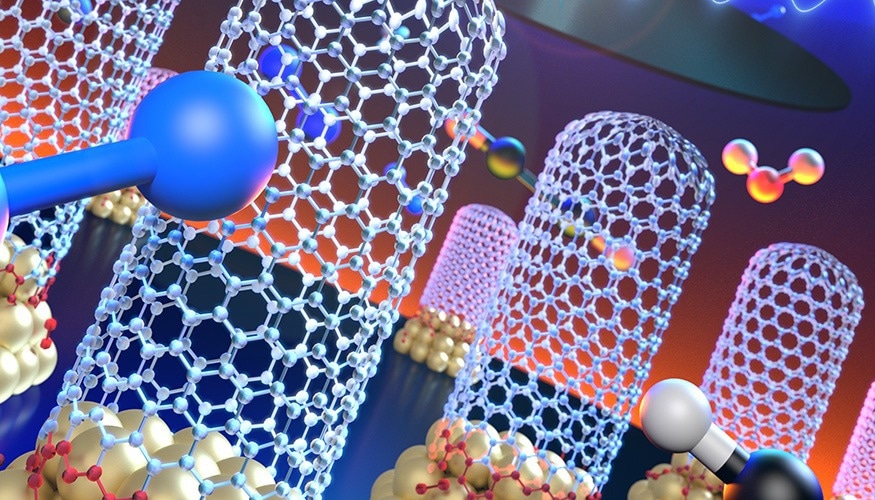Oct 26 2022Reviewed by Mila Perera
Researchers from the Lawrence Livermore National Laboratory (LLNL) are expanding the creation of vertically aligned single-walled carbon nanotubes (SWCNT) that could transform various commercial products ranging from automotive parts, rechargeable batteries, and sporting goods to water filters and boat hulls.

Vertically aligned carbon nanotubes growing from catalytic nanoparticles (gold color) on a silicon wafer on top of a heating stage (red glow). Diffusion of acetylene (black molecules) through the gas phase to the catalytic sites determines the growth rate in a cold-wall showerhead reactor. Image Credit: Adam Samuel Connell/LLNL
The study has been published in the Carbon journal.
The majority of CNT production at present is utilized in thin films and mass composite materials, which depend on disorganized CNT architectures. For several uses, organized CNT architectures, such as vertically aligned forests, offer significant benefits for using the properties of separate CNTs in macroscopic systems.
Robust synthesis of vertically-aligned carbon nanotubes at large scale is required to accelerate deployment of numerous cutting-edge devices to emerging commercial applications.
Francesco Fornasiero, Study Lead Author and Scientist, Lawrence Livermore National Laboratory
Fornasiero added, “To address this need, we demonstrated that the structural characteristics of single-walled CNTs produced at wafer scale in a growth regime dominated by bulk diffusion of the gaseous carbon precursor are remarkably invariant over a broad range of process conditions.”
The researchers discovered that the vertically oriented SWCNTs maintained high quality when the precursor concentration (the initial carbon) rose 30-fold. Also, the catalyst substrate area rose from 1 cm2 to 180 cm2. Furthermore, the gas flow rates rose 8-fold, and pressure grew from 20 to 790 Mbar.
Researchers from LLNL presented a kinetics model showing that growth kinetics could be expedited by utilizing a lighter bath gas to support precursor diffusion. Furthermore, it illustrated that byproduct formation becomes increasingly more significant at higher growth pressure. This could be considerably eased by utilizing a hydrogen-free growth environment.
The model also shows that the appropriate choice of the CNT growth recipe and fluid dynamics conditions can increase the production throughput by 6-fold and the carbon conversion efficiency to more than 90%.
These model projections, along with the remarkably conserved structure of the CNT forests over a wide range of synthesis conditions, suggest that a bulk-diffusion-limited growth regime may facilitate preservation of vertically aligned CNT-based device performance during scale up.
Jin Park, Study First Author and Scientist, Lawrence Livermore National Laboratory
The researchers concluded that functioning in a growth regime that a simple CNT growth kinetics model quantitatively explains can assist process optimization and result in quicker deployment of cutting-edge vertically aligned CNT applications.
Applications include water purification, lithium-ion batteries, thermal interfaces, breathable fabrics, sensors, and supercapacitors.
The other LLNL authors of the study are Kathleen Moyer-Vanderburgh, Steven Buchsbaum, Eric Meshot, Melinda Jue, and Kuang Jen Wu. The work has been financially supported by the Biological and Chemical and Technologies Department of the Defense Threat Reduction Agency.
Journal Reference
Park, S. J., et al. (2022) Synthesis of wafer-scale SWCNT forests with remarkably invariant structural properties in a bulk-diffusion-controlled kinetic regime. Carbon. https://doi.org/10.1016/j.carbon.2022.09.068.
Source: https://www.llnl.gov/